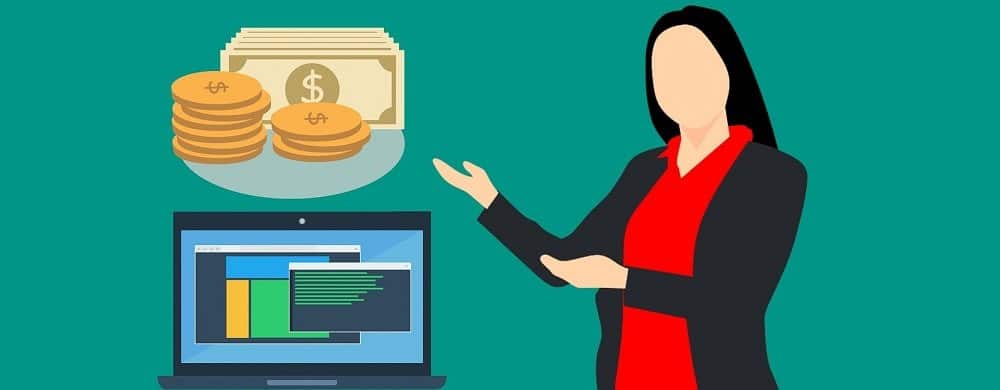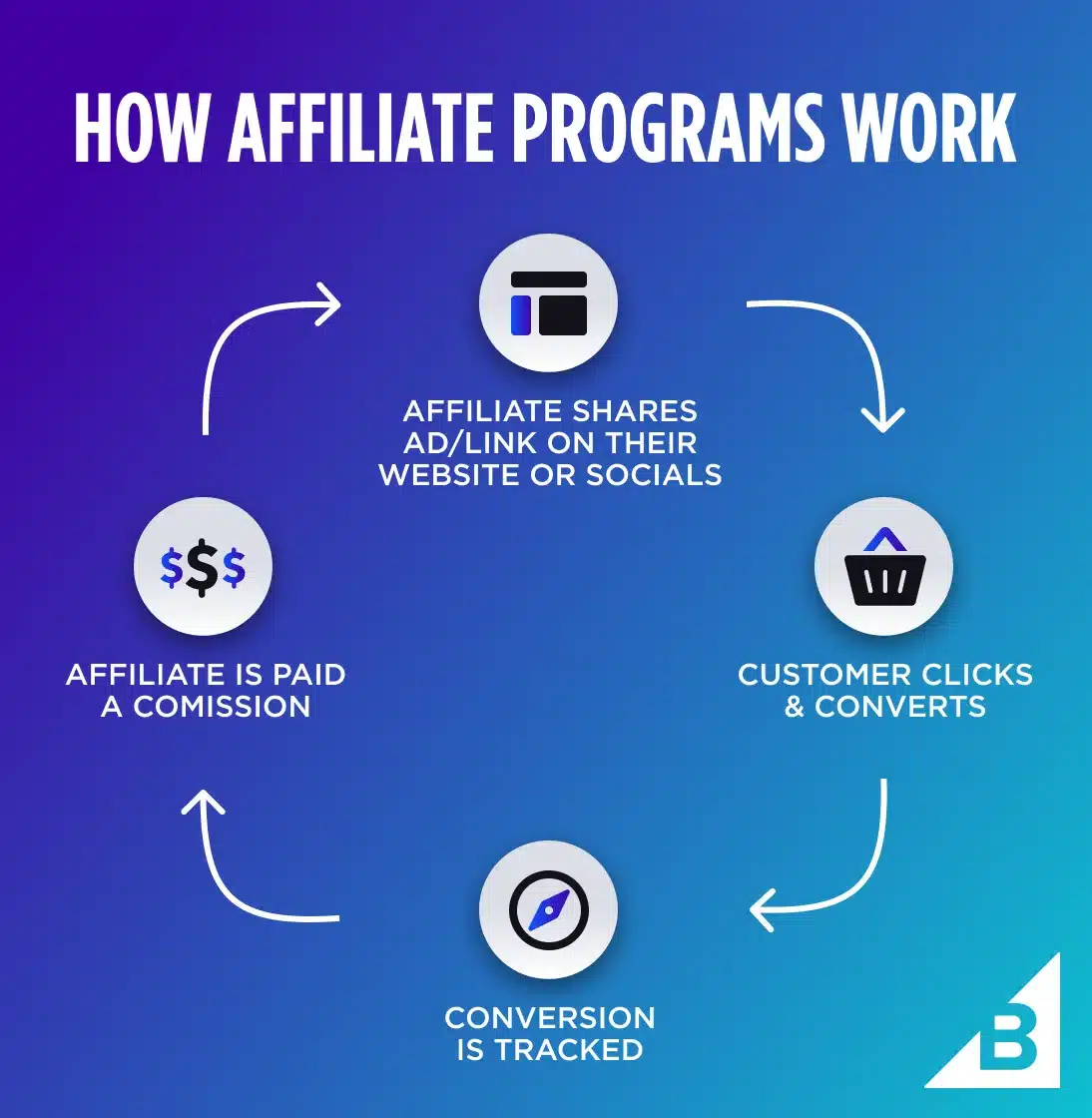Looking to monetize your blog or social media influence? Our comprehensive guide on “What is Affiliate Marketing?” at HowtoJoinAffiliatePrograms.com is your ultimate resource. Tailored specifically for bloggers and influencers, this page demystifies the world of affiliate marketing, turning your online presence into a lucrative venture.
We cover everything from the basic definition—earning commissions by promoting others’ products—to advanced strategies for success. Learn how tracking cookies work, discover various payment models, and explore different types of affiliate marketing. We also delve into the pros and cons, helping you make an informed decision.
Whether you’re a fashion blogger, tech YouTuber, or travel Instagrammer, we’ve got niche-specific examples to inspire you. Plus, our in-depth reviews of top programs like Amazon Associates, Shopify, and CJ Affiliate help you choose the best fit.
With real-life success stories and practical FAQs, this guide equips you with the knowledge to transform your passion into profit. It’s not just about earning; it’s about recommending products you truly believe in. Start your affiliate marketing journey today with our expert guidance.
What is Affiliate Marketing? A Complete Guide for Bloggers & Influencers
What is Affiliate Marketing, Really?

At its core, affiliate marketing is a performance-based business model where you (the affiliate) earn a commission for promoting someone else’s products or services. But let’s not be so textbook about it. In the real world, it’s more like this:
Imagine you’re a respected voice in your community. Maybe you’re the go-to person for book recommendations in your local book club. Every time you rave about a novel, a dozen people rush to the bookstore. Now, what if the bookstore owner said, “Hey, your recommendations drive so much business. How about I give you 10% of every sale that comes from your suggestions?” That’s affiliate marketing, but online.
In the digital realm, you’re not just the local book guru; you’re a blogger, YouTuber, Instagrammer, or TikToker with an audience that trusts your opinion. Instead of a physical bookstore, you’re partnering with online businesses. Your “recommendations” are affiliate links, and your “commission” is a slice of each sale.
Real-World Examples
- Fashion Blogger: You write a post titled “10 Dresses That Make Me Feel Like a Queen.” Each dress link is an affiliate link. When a reader buys that dreamy maxi dress, you earn maybe 7% of the sale.
- Tech YouTuber: Your “Honest Review: This Laptop Survived My Coffee Spill!” video goes viral. That Amazon link in your description? Every purchase nets you a commission.
- Instagram Fitness Guru: You share a post-workout selfie, mentioning your favorite protein shake. Followers swipe up, buy the shake, and you earn.
- Personal Finance Blogger: Your article “How I Raised My Credit Score 100 Points” recommends a credit monitoring service. Each signup brings you $50.
The beauty? Scale. That local bookseller might give you a few dollars here and there. But online, with thousands or millions following you, those small commissions add up fast.
How Does Affiliate Marketing Actually Work?

You’ve got the concept, but what’s happening behind the scenes? It’s not magic (though sometimes the payouts can feel that way). It’s all about tracking, attribution, and trust.
- Joining the Club: First, you apply to affiliate programs. Some, like Amazon Associates, are open to nearly everyone. Others, like high-end fashion brands, might want to see your stats and content quality. Once accepted, you’re “in the club.”
- Your Digital Business Cards: The program provides unique links or promo codes. Think of these as your personal business cards. When someone uses your card (link) at a store (website), the store knows you referred them.
- Planting Your Flag: You sprinkle these links in your content:
- Blog posts: “My Top 5 DSLR Cameras for Beginners” (with affiliate links)
- YouTube: “The Only Skincare I’d Repurchase” (links in description)
- Instagram Story: “My go-to leggings for hot yoga 🧘♀️” (swipe-up link)
- Twitter: “This budgeting app changed my finances 📈 [affiliate link]”
- The Cookie Trail: When someone clicks your link, a small file called a cookie is placed on their browser. It’s like a flag saying, “This visitor came from @FashionistaJane’s blog!” Most cookies last 30 days, but it varies—Amazon’s is 24 hours, while some programs offer 90 days.
- Ka-ching Moment: If that person buys within the cookie’s lifespan, you get credited. Even if they initially clicked your camera review but ended up buying socks, as long as that cookie is active, you earn.
- Beyond the Sale: Some programs offer more:
- Pay per Lead (PPL): You earn when someone signs up for a trial or newsletter.
- Pay per Install (PPI): Great for app promoters. You get paid when someone downloads and installs.
- Pay per Click (PPC): Rare, but you earn a tiny amount for each link click.
- Commission Structures:
- Percentage of Sale: Most common. 5% to 25% is standard, but it can go higher.
- Flat Rate: “$50 for each web hosting signup,” for example.
- Tiered: The more you sell, the higher your rate. Motivation to hustle!
- Two-Tier: You also earn from affiliates you recruit. Your referral sells a product, you get a cut of their commission.
- Getting Paid: Once you hit the payment threshold (often $50 or $100), you can cash out. This might be monthly or whenever you request. Payment forms:
- Direct bank transfer (most professional)
- PayPal (quick and global)
- Check (old school, slower)
- Store credit (less common, good if you love the brand)
The Tech Behind the Scenes: For the tech-curious, here’s what’s happening:
- You get a base URL: https://brandname.com/product?affid=YourUniqueID
- When clicked, it routes through tracking software like HasOffers or Impact.
- This software logs the click, assigns the cookie, and redirects to the product page.
- If a purchase happens, the software cross-references the buyer’s cookie with its database.
- Match found? Commission calculated and credited to you.
Some programs also offer deep-linking tools. Instead of generic “brandname.com,” you can create brandname.com/exact-blue-sweater-you-mentioned. This relevance boosts click-through rates.
Is Affiliate Marketing Really Worth It?

Ah, the million-dollar question—quite literally for some top affiliates. The short answer? Yes, it can be incredibly worth it. But (there’s always a “but”) it requires work, strategy, and patience.
The Resounding “Yes” Cases
- Passive Income Dream: Michelle Schroeder-Gardner’s story is affiliate folklore. Her blog, Making Sense of Cents, started as a side gig. Now? She consistently earns over $50,000 per month from affiliates. Her personal finance advice aligns perfectly with the credit cards, investment tools, and budgeting apps she promotes.
- Tech Titan: Marques Brownlee (MKBHD) isn’t just a YouTuber; he’s a tech institution. With over 15 million subscribers, his gadget reviews drive massive sales. A single video about noise-canceling headphones can net him tens of thousands in affiliate commissions.
- Niche Power: Don’t think you need millions of followers. Becky Goddard-Hill’s craft and parenting blog, A Beautiful Space, earns her a full-time income. By focusing on specific niches like eco-friendly toys and homeschooling resources, her targeted recommendations convert incredibly well.
- Diverse Streams: Pat Flynn of Smart Passive Income is an affiliate marketing maestro. He doesn’t just use one stream; he dabbles in hosting services, email tools, and course platforms. This diversification helps him pull in over $100,000 monthly, with a significant chunk from affiliates.
These aren’t just outliers. A survey by Influencer Marketing Hub found that 9% of affiliate marketers earn over $50,000 yearly. Around 65% make enough to sustain a full-time income.
Why It’s Worth Your Time
- Low Entry Barrier: Unlike dropshipping or creating courses, affiliate marketing requires minimal upfront costs. No inventory, no product development—just your platform and voice.
- Flexibility: Recommend fashion in the morning, tech at noon, and recipes at night. There’s an affiliate program for every niche, allowing you to stay true to your diverse interests.
- No Customer Service Hassles: Product arrived damaged? Buyer wants a refund? Not your problem. The merchant handles all customer service, letting you focus on content.
- Try Before You Buy: Many programs offer affiliates free products. That $1,000 camera you’re reviewing? Often, it’s sent to you gratis. You get to try top-tier products without the top-tier price.
- Tangible Impact: When a follower comments, “I bought this router on your advice, and my Wi-Fi issues are finally solved!” it’s rewarding. You’re not just earning; you’re genuinely helping.
- Scalability: Your old blog post about “Best Writing Tools” can still earn years later. As you produce more content, your earnings potential compounds without necessarily increasing your workload.
- Builds Authority: Being selective with affiliations can boost your credibility. When followers see you’re choosy, recommending only products you truly believe in, your authority grows.
But… Challenges Exist
- Trust is Your Currency: Promote a subpar product for a high commission, and you might earn big once. But you’ll lose followers’ trust. In the long run, that trust was worth far more than the one-time payout.
- Content is King, Not Links: Beginners often fall into the “link dump” trap. A post that’s just a list of affiliate links won’t convert. You need compelling content that naturally integrates recommendations.
- Competition is Fierce: Every niche has established influencers. Standing out requires consistency, quality, and often, a unique angle. A saturated field like “travel gear” is tough, but “ultralight gear for senior backpackers” could be your golden ticket.
- Algorithm Changes Sting: Many affiliates lean heavily on SEO or social media. But when Google tweaks its algorithm or Instagram shifts its feed, traffic can plummet overnight. Diversification is key.
- Some Programs Have Issues:
- Low commissions (1% doesn’t add up unless you’re high-volume)
- Short cookie lifespans (24 hours is common but limiting)
- Delayed payments (some programs pay 60-90 days after a sale)
- Poor tracking (sadly, some miss attributions)
- Disclosure is a Must: FTC guidelines require you to disclose affiliate relationships. While most followers understand and appreciate transparency, some may feel your recommendations are “just for money.”
- Time Investment: Creating in-depth reviews, staying updated on products, and engaging with your audience takes time. Affiliate marketing isn’t passive until you’ve front-loaded a lot of work.
So… Is It Worth It for YOU?
To decide, ask yourself:
- Do you genuinely enjoy reviewing and recommending products?
- Is your audience engaged, not just large?
- Are you in a niche with good affiliate opportunities?
- Can you create high-quality, genuine content consistently?
- Are you patient enough to see slow growth before big wins?
If you answered “yes” to most of these, then affiliate marketing isn’t just worth trying—it’s worth mastering.
The Affiliate Marketing Landscape

Affiliate marketing isn’t new—Amazon launched its program back in 1996. But it’s evolved dramatically. What was once a side hustle for tech bloggers is now a viable career across every niche:
- Beauty & Fashion: From indie skincare to haute couture
- Tech: Smartphones, laptops, smart home gear
- Finance: Credit cards, robo-advisors, tax software
- Travel: Booking sites, luggage, travel insurance
- Fitness: Workout programs, supplements, apparel
- Home & DIY: Power tools, decor, meal kits
- Gaming: Consoles, titles, streaming gear
- Education: Online courses, language apps, tutoring platforms
The rise of influencer culture has supercharged affiliate marketing. Your audience doesn’t just tolerate recommendations; they actively seek your opinion. In a world of endless choices, a trusted voice saying “This one. Trust me.” is invaluable.
Moreover, brands get it now. They’re not just looking at follower counts; they’re looking at engagement rates, audience demographics, and content quality. A micro-influencer with 10,000 dedicated fans in a specific niche might be more valuable than a general “celebrity” with a million passive followers.
Payment structures are evolving too. Some luxury brands now offer 25% or more on high-ticket items. Others provide bonuses for consistent performance. There’s even a rise in “affiliate networks” like CJ Affiliate or ShareASale, which let you apply once and access hundreds of brand programs.
But here’s the thing: as affiliate marketing grows, so does its complexity. Cookie stuffing (overwriting others’ cookies), link cloaking, multi-channel attribution—the tech side is getting dense. While you don’t need a computer science degree, staying informed helps. Follow blogs like STM Forum to keep up with trends.
Ethics are another hot topic. Some argue that affiliate marketing can push consumerism, encouraging followers to buy things they don’t need. Others debate whether recommending a product you got for free is truly unbiased. These are questions worth pondering. Your stance on them will shape your affiliate approach.
Final Thoughts: Your Role in the Ecosystem
Affiliate marketing, at its best, is symbiotic:
- Brands get targeted promotions and sales.
- Consumers get informed recommendations.
- You, the affiliate, get to monetize your influence.
But you’re not just a cog in this machine; you’re its heart. Your authenticity, expertise, and connection with your audience drive everything. A brand can have the highest commission, but if it doesn’t align with your values or your followers’ needs, it’s not worth it.
Remember, too, that affiliate marketing doesn’t have to be your only income stream. Many top bloggers and influencers use it as part of a diversified strategy:
- Affiliate income for steady earnings
- Sponsored posts for big paydays
- Digital products (e-books, courses) for high-margin sales
- Ad revenue for passive income
This mix provides stability and scalability. As your affiliate earnings grow, they can fund other ventures—maybe that travel photography course you’ve been dreaming of launching.
So, is affiliate marketing worth it in 2024 and beyond? If you’re a blogger or influencer who values authenticity, enjoys reviewing products, and wants to monetize without compromising integrity—then yes, a thousand times yes. It’s not just worth it; it’s one of the most aligned ways to earn from your digital presence.
The path won’t always be smooth. There will be products that flop, commissions that take ages to arrive, and days when you wonder if anyone’s even clicking. But stick with it. Choose programs thoughtfully, create content passionately, and always, always put your audience’s trust first.
Do that, and affiliate marketing won’t just be a side income. It’ll be a reflection of your influence—a tangible measure of how much your voice matters in the noisy digital world. Now, isn’t that worth pursuing?
Reputable Affiliate Marketing Programs and How to Join Them

- CJ Affiliate: Formerly Commission Junction. Offers a vast range of brands like Barnes & Noble and IHG Hotels. Known for high commissions and timely payments. Please check the CJ affiliate program page for more details.
- Impact Radius: Modern interface with big names like Uber and Airbnb. Offers detailed analytics and is favored for its transparency. We have listed the 15 best affiliate programs on Impact Radius that you may want to check out. Also you can read our review on the Impact Radius affiliate program.
- Amazon Associates: The giant. Easy to join, with millions of products. Commissions vary (1% to 10%), but conversion rates are high due to trust in Amazon. We have a complete guide on how to promote your Amazon CPA offers. Take a look.
- Shopify: Perfect for e-commerce bloggers. Earn up to $2,000 per merchant you refer. They also offer a 200% bounty on their first two payments. If you want to join this program, please check our review and guide on how to join the Shopify affiliate program.
- Home Depot: DIY bloggers, rejoice! Commissions range from 1% to 8%. Their extensive product range, from tools to appliances, is a plus. We have made a complete review about the Home Depot affiliate program. If you want to know the Pros and Cons and how to join it, check our guide. We even added other similar programs as alternative.
- Samsung: Tech influencers, take note. Offers up to 6% on their vast range, from phones to TVs. Their brand reputation boosts conversions. You can join the Samsung affiliate program from this page.
- eBay: Great for variety. Rate starts at 1% but can reach 4% for top performers. Perfect if you cover many niches.
- HubSpot: B2B bloggers, this is for you. High ticket items mean big commissions—up to $1,000 per sale. Their resources also help you succeed. Check out all the HubSpot affiliate program details on its page.
Conclusion
Affiliate marketing is a powerful way for bloggers and influencers to monetize their passion. It’s not just about earning; it’s about recommending products you genuinely believe in. This trust-based model benefits everyone: brands get sales, you get commissions, and your audience gets valuable recommendations.
Remember, success doesn’t happen overnight. It requires quality content, audience engagement, and persistence. But with the right approach, affiliate marketing can transform your online presence from a hobby into a thriving business.
Ready to start? Choose a niche, select a few programs that resonate with you, and begin creating content. Your journey in affiliate marketing starts now. Best of luck!
Also, stay up to date with the latest affiliate programs trends by following us on: Facebook, Instagram, X, and Pinterest.
FAQs
Q: How much can I realistically earn from affiliate marketing?
A: It varies greatly. Beginners might make $100-$500/month, while established affiliates can earn $10,000+ monthly.
Q: Do I need a large following to start?
A: Not necessarily. An engaged niche audience can be more valuable than a large, disinterested one.
Q: Can I do affiliate marketing on any platform?
A: Yes, but always disclose your affiliate relationships to comply with FTC guidelines.
Q: How do I choose the right products?
A: Pick items you’d genuinely recommend, align with your niche, and have good commission rates.
Q: Is it better to promote high-ticket or low-ticket items?
A: Both have merits. High-ticket means bigger commissions but fewer sales. Low-ticket items sell more but earn less per sale.
Q: How often should I share affiliate links?
A: Quality over quantity. Integrate them naturally without overwhelming your audience.
Q: Can affiliate links affect my SEO?
A: If overused, yes. Use them judiciously and consider link cloaking to make links appear more natural.
Q: What if a product I promote disappoints my audience?
A: Always be honest. Acknowledge the issue, and it can even boost your credibility.
Q: Should I join multiple affiliate programs?
A: Yes, it diversifies your income. But master a few before expanding.
Q: Do commissions ever expire?
A: Some do. Always check the cookie duration in each program’s terms.

